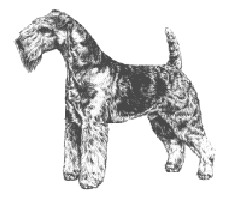Lakeland Terrier
General Information - Lakeland Terrier

Group:
Terrier
Size:
medium
Lifespan:
12-16 years
Exercise:
moderate
Grooming:
high
Trainability:
very hard
Watchdog ability:
very high
Protection ability:
very low
Area of Origin:
England
Date of Origin:
1700’s
Other Names:
none
Original Function:
Vermin hunting
History
The Lakeland Terrier was originally called the Patterdale Terrier. It was developed from crossings between the Bedlington and the Old English Wirehaired Terrier in England's Lake District. It was used to hunt den animals such as badger and fox, and also otter. This dog hunted in water and uneven terrain and was expected to chase and kill the quarry. This beautiful, spunky terrier has since become a popular companion and a successful show dog.
Temperament
Confident and willing the Lakeland Terrier loves children. This breed can be a barker, a digger and may guard its toys. Lakeland Terriers get along with other dogs but should be taught not to chase cats at a young age. Feisty and cheerful, the Lakeland Terrier loves to be the centre of his owner's life.
Upkeep
This is an active breed that needs daily entertainment or it will make it for itself. A moderate walk on leash or a hardy game in the yard can usually satisfy its needs, but it also enjoys the chance to explore off leash in a safe area. It enjoys spending the day in a secure yard, but it should optimally sleep in the house. Its wire coat needs combing one or two times weekly, plus scissoring and shaping (clipping for pets and stripping for show dogs) four times yearly.
Lakeland Terrier
A breed standard is the guideline which describes the ideal characteristics, temperament, and appearance of a breed and ensures that the breed is fit for function with soundness essential. Breeders and judges should at all times be careful to avoid obvious conditions and exaggerations, as well as being mindful of features which could be detrimental in any way to the health, welfare or soundness of this breed.
Breed Standard - Lakeland Terrier
 General Appearance:
General Appearance: Smart and workman-like, with gay fearless demeanour.
Head and Skull: Well balanced. Skull flat and refined. The jaws powerful and the muzzle should be broad but not too long. The length of the head from the stop to the tip of the nose should not exceed that from the occiput to the stop. Nose black.
Eyes: Should be dark or hazel.
Ears: Moderately small, V-shaped and carried alertly. They should not be placed too high or too low on the head.
Mouth: Teeth even, closing scissor fashion, i.e. top teeth fitting closely over lower.
Neck: Reachy.
Forequarters: Shoulders well laid back. Forelegs straight, well boned.
Body: Chest reasonably narrow. Back strong, moderately short, well-coupled.
Hindquarters: Strong and muscular, thighs long and powerful, well-turned stifles, hocks low to ground and straight.
Feet: Small, compact, round and well-padded.
Tail: Customarily docked. Well set on, carried gaily but not to curl over the back.
Coat: Dense and weather resisting, harsh with good undercoat.
Colour: Black and tan, blue and tan, red, wheaten, red grizzle, liver, blue or black. Small tips of white on feet and chest not to debar. Mahogany or deep tan is not typical.
Weight and Size: The average weight of dogs is 7.7 kg (17 lb), bitches 6.8 kg (15 lb). The height should not exceed 36.8 cm (14.5 in) at the shoulder.
Faults: A true Lakeland Terrier expression is determined by head, ears and eyes. Too long a head, ears set on the top of the head, and slanting eye, are faults.
Note: Male animals should have two apparently normal testicles fully descended into the scrotum.
DNZ No 252
Copyright Dogs New Zealand
23 Dec 2013
Any departure from the foregoing points should be considered a fault and the seriousness with which the fault should be regarded should be in exact proportion to its degree and its effect upon the health and welfare of the dog and on the dog’s ability to perform its traditional work.




